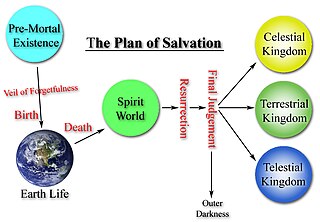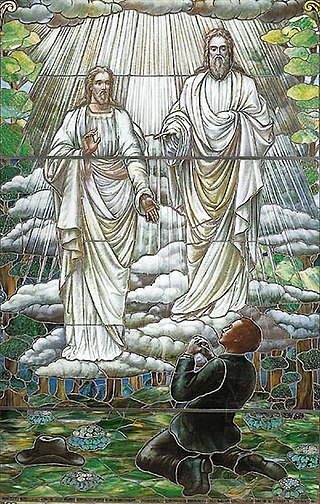Related Research Articles

The Standard Works of the Church of Jesus Christ of Latter-day Saints are the four books that currently constitute its open scriptural canon. The four books of the standard works are:
In the Latter Day Saint movement, an evangelist is an ordained office of the ministry. In some denominations of the movement, an evangelist is referred to as a patriarch. However, the latter term was deprecated by the Community of Christ after the church began ordaining women to the priesthood. Other denominations, such as The Church of Jesus Christ (Bickertonite), have an evangelist position independent of the original "patriarch" office instituted movement founder Joseph Smith.

Mormonism is the theology and religious tradition of the Latter Day Saint movement of Restorationist Christianity started by Joseph Smith in Western New York in the 1820s and 1830s. As a label, Mormonism has been applied to various aspects of the Latter Day Saint movement, although there has been a recent push from the Church of Jesus Christ of Latter-day Saints to distance themselves from this label. A historian, Sydney E. Ahlstrom, wrote in 1982 that, depending on the context, the term Mormonism could refer to “a sect, a mystery cult, a new religion, a church, a people, a nation, or an American subculture; indeed, at different times and places it is all of these."

In Latter Day Saints theology, the term spirit world refers to the realm where the spirits of the dead await the resurrection. In LDS thought, this spirit world is divided into at least two conditions: Paradise and spirit prison:
In the Latter Day Saint movement, priesthood is the power and authority of God given to man, including the authority to perform ordinances and to act as a leader in the church. A group of priesthood holders is referred to as a quorum.

The Church of Jesus Christ is an international Christian religious denomination headquartered in Monongahela, Pennsylvania, United States. Organized at Green Oak, Pennsylvania, U.S.A. in the year 1862. The church is a Christian Restorationist church and accepts the Book of Mormon as scripture. The church considers itself the gospel restored, or the original church and good news as established by Jesus Christ in the New Testament, restored upon the earth. It also claims to be the spiritual successor to the Church of Christ, organized by Joseph Smith on April 6, 1830. The church sees Sidney Rigdon as Smith's rightful successor following the assassination of Smith because Rigdon was Smith's first counselor in the First Presidency. The church is not officially affiliated with any other church, organization or denomination.

The Church of Christ was the original name of the Latter Day Saint church founded by Joseph Smith. Organized informally in 1829 in Upstate New York and then formally on April 6, 1830, it was the first organization to implement the principles found in Smith's newly published Book of Mormon, and thus its establishment represents the formal beginning of the Latter Day Saint movement. Later names for this organization included the Church of the Latter Day Saints, the Church of Jesus Christ, the Church of God, the Church of Christ of Latter Day Saints, and the Church of Jesus Christ of Latter Day Saints.
The Church of Jesus Christ of Latter-day Saints has several unique teachings about Judaism and the House of Israel. The largest denomination in the Latter Day Saint movement, the LDS Church teaches the belief that the Jewish people are God's chosen people and it also teaches the belief that its members share a common and literal Israelite ancestry with the Jewish people.
Prima scriptura is the Christian doctrine that canonized scripture is "first" or "above all" other sources of divine revelation. Implicitly, this view suggests that, besides canonical scripture, there can be other guides for what a believer should believe and how they should live, such as the Holy Spirit, created order, traditions, charismatic gifts, mystical insight, angelic visitations, conscience, common sense, the views of experts, the spirit of the times or something else. Prima scriptura suggests that ways of knowing or understanding God and his will that do not originate from canonized scripture are perhaps helpful in interpreting that scripture, but testable by the canon and correctable by it, if they seem to contradict the scriptures. Prima sciptura is upheld by the Anglican, Methodist and Pentecostal traditions of Christianity, which suggest that Scripture is the primary source for Christian doctrine, but that "tradition, experience, and reason" can nurture the Christian religion as long as they are in harmony with the Bible.

In the Latter Day Saint movement, confirmation, is an ordinance essential for salvation. It involves the laying on of hands and is performed after baptism. Through confirmation, the initiate becomes an official member of the church and receives the gift of the Holy Ghost. Baptism and confirmation are administered to persons at least eight years old. The ordinance corresponds to the confirmation rite in many other Christian faiths. Confirmations were first performed on April 6, 1830, at the organizational meeting of the Church of Christ.

Within the Latter Day Saint movement, the "Articles of Faith" is a statement of beliefs composed by Joseph Smith as part of an 1842 letter sent to "Long" John Wentworth, editor of the Chicago Democrat, and first published in the Latter Day Saint newspaper Times and Seasons. It is a concise listing of thirteen fundamental doctrines of Mormonism. Most Latter Day Saint denominations view the articles as an authoritative statement of basic theology. Some denominations, such as the Church of Jesus Christ of Latter-day Saints, have adopted the articles as scripture. For some sects, the Articles of Faith are known collectively as "An Epitome of Faith and Doctrine".

Restoration Branches movement is a Christian/Latter Day Saint religious sect which was formed in the 1980s by members of the Reorganized Church of Jesus Christ of Latter Day Saints in a reaction against the events of the RLDS 1984 world conference. The movement holds in the traditional RLDS theology of the 19th and early-to-mid 20th centuries and hold that events leading up to and surrounding the 1980s and decades since have introduced sweeping, fundamental changes into RLDS doctrine and practice which are illegitimate because they contradict the long-standing RLDS theological tradition this sect holds as true. It is also a part of the Mormon religion.

According to the doctrine of the Church of Jesus Christ of Latter-day Saints, the largest denomination in the Latter Day Saint movement, the plan of salvation is a plan God created to save, redeem, and exalt humankind, through the atonement of Jesus Christ. The elements of this plan are drawn from various sources, including the Bible, Book of Mormon, Doctrine & Covenants, Pearl of Great Price, and numerous statements made by the leadership of the Church of Jesus Christ of Latter-day Saints. The first appearance of the graphical representation of the plan of salvation was provided in the 1952 missionary manual entitled A Systematic Program for Teaching the Gospel.

In the theology and cosmology of The Church of Jesus Christ of Latter-day Saints, in heaven there are three degrees of glory which are the ultimate, eternal dwelling places for nearly all who have lived on earth after they are resurrected from the spirit world.
In Mormonism, revelation is communication from God to man. Latter Day Saints teach that the Latter Day Saint movement began with a revelation from God, which began a process of restoring the gospel of Jesus Christ to the earth. Latter Day Saints also teach that revelation is the foundation of the church established by Jesus Christ and that it remains an essential element of his true church today. Continuous revelation provides individual Latter Day Saints with a "testimony", described by Richard Bushman as "one of the most potent words in the Mormon lexicon".
Members of the Church of Jesus Christ of Latter-day Saints and other adherents in the Latter Day Saint movement, believe that there will be a Second Coming of Jesus Christ to the earth sometime in the future. The LDS Church and its leaders do not make predictions of the actual date of the Second Coming.

In the Latter Day Saint movement, baptism is recognized as the first of several ordinances (rituals) of the gospel.

The Church of Jesus Christ of Latter-day Saints focuses its doctrine and teaching on Jesus Christ; that he was the Son of God, born of Mary, lived a perfect life, performed miracles, bled from every pore in the Garden of Gethsemane, died on the cross, rose on the third day, appeared again to his disciples, and now resides, authoritatively, on the right hand side of God. In brief, some beliefs are in common with Catholics, Orthodox and Protestant traditions. However, teachings of the LDS Church differ significantly in other ways and encompass a broad set of doctrines, so that the above-mentioned denominations usually place the LDS Church outside the bounds of orthodox Christian teaching as summarized in the Nicene Creed.
Repentance is a stage in Christian salvation where the believer acknowledges and turns away from sin. As a distinct stage in the ordo salutis its position is disputed, with some theological traditions arguing it occurs prior to faith and the Reformed theological tradition arguing it occurs after faith. In Catholic theology, Lutheran theology, Orthodox theology and Anglican theology, repentance plays a key role in Confession and Absolution.
Continuous revelation or continuing revelation is a theological belief or position that God continues to reveal divine principles or commandments to humanity.
References
- ↑ "Archived copy". Archived from the original on 2011-06-05. Retrieved 2015-03-29.
{{cite web}}: CS1 maint: archived copy as title (link)
- Smith, Joseph Jr. (1 March 1842a), "Church History [Wentworth Letter]", Times and Seasons , 3 (9): 706–10.